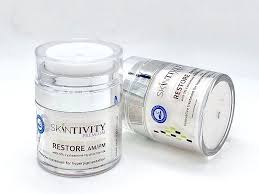Cysteamine in Skin Care
Cysteamine is a new cosmeceutical ingredient used in skin lightening products.
It is relatively new ingredient used to lighten dark spots because for years the compound was considered too unstable to last on shelves before turning rancid.
New processes have been developed which prevent degradation and enable this ingredient’s use in modern skin care. (4,5)
Cysteamine is great for treating dark spots and preventing sun damage, but it isn’t perfect for every skin type. It is a tyrosinase inhibitor.
Cysteamine is the simplest compound in the aminothiol Family. It is naturally present in the body.
Aminothiols are used as protective ingredients against radiation.
It can be found in many mammal tissues, but is found in highest natural concentrations in mammal milk.(3)
To make sure cysteamine is right for your skin, shop by your Baumann Skin Type!
Benefits
The primary benefit of cysteamine is that it is much safer as a skin lightener than hydroquinone with comparable efficacy.
Other skin lighteners such as kojic acid are a little less irritating to skin, but also less effective.
Because it also absorbs radiation, this ingredient may help prevent sun burns and sun damage when used in combination with sunscreen.
Which skin types should use Cysteamine?
Skin types that are not sensitive to inflammation are good candidates for this potent skin lightening ingredient. That being said, not all skin types require a lightening ingredient in their regimen. The skin types that we think this ingredient is best for are:
Skin type 9: ORPT
Skin type 11: ORPW
Skin type 13: DRPT
Skin type 15: DRPW
Basically, if your skin is resistant to inflammation and also has irregular pigmentation, cysteamine is a great choice for you.
Which skin types should avoid cysteamine?
In general, the skin types that should avoid cysteamine are those prone to inflammation. Inflammation can lead to subsequent conditions like post inflammatory hyperpigmentation, redness, or stinging in general.
If your skin type has sensitivity and inflammation as one of their barriers to skin health, you should avoid this ingredient. If you use an anti-inflammatory alongside cysteamine, however, there is less risk of inflammation even for sensitive types.
In particular, we advise the following skin types to consider skin lighteners with less abrasive sensations if they do not also have anti-inflammatories:
Skin type 1: DSPT
Skin type 2: DSNT
Skin type 3: DSPW
Skin type 4: DSNW
Skin type 5: OSPT
Skin type 6: OSNT
Skin type 7: OSPW
Skin type 8: OSNW
This is to say that sensitive skin types, whether they are pigmented or not, are not always the best candidates for cysteamine in their custom regimens.
Side effects
There are a few common short term side effects from using cysteamine products, but none of them are true threats to your skin health.
It is common to experience mild redness and stinging for about 30 minutes; this is completely normal and safe during the first few days of treatment.
If continued use of cysteamine products is irritating your skin, consider layering an anti-inflammatory product on top.
No studies surrounding usage while pregnant or breast-feeding have been done, so it is recommended to avoid products containing this ingredient under those conditions until research is produced.
If you are pregnant, there are multiple effective and proven safe treatments for hyperpigmentation conditions like melasma.
This ingredient is also worth avoiding if you have vitiligo, as the treatments for vitiligo involve producing more melanin, not inhibiting pigment production with tyrosinase inhibitors.
Is cysteamine safe?
It is considered completely safe for use in skin care as long as it is used properly within your custom skin care regimen!
The EWG rating for cysteamine is “1” which means there are no commonly associated risks or concerns with this ingredient.
Many studies on this ingredient have found it to be a safe alternative to the controversial hydroquinone, which itself has a few associated risks.(7)
As a naturally occurring compound in the human body, cysteamine is entirely non-toxic and safe to use depending on your skin concerns.
cysteamine for hyperpigmentation
For hyperpigmentation
Cysteamine is an effective skin lightening ingredient which is more easily absorbed by the human body than competing skin lighteners.It is a potent tyrosinase inhibitor.
It becomes increasingly common as a skin lightening ingredient every year as more research comes out to support its efficacy.(5)
It is considered the most effective natural compound for the treatment of melasma.
Unlike other skin lighteners like hydroquinone, this ingredient is free of many common concerns having to do with mutagenicity or carcinogenicity.
In fact, it has demonstrated anti-carcinogenic and anti-mutagenic properties. (3)
Despite its effectiveness, some people find the irritating initial feeling of cysteamine uncomfortable.
You may get faster results if you combine cysteamine together with some of these other skin lighteners:
Arbutin
Avocado oil
Ferulic acid
Hexylresorcinol
Kojic acid
Licorice extract
Resorcinol
DQH Can I use salicylic acid first and then vitamin C?
It’s easy to create a skincare routine, but knowing how to use it is another thing entirely. In most cases, if you’re not getting the desired skin results, it could be due to the layering of conflicting ingredients. So, is it possible that salicylic acid and vitamin C are such ingredients? Or are these active ingredients the duo that’s been missing from your skincare routine? If you want answers, stick around because today we are going to explain the benefits of salicylic acid and vitamin C and how they can be used in your daily life.
What are the benefits of salicylic acid for skin?
Salicylic acid is one of the most commonly used beta hydroxy acids and is favored by many people with oily, acne-prone skin. This acid is derived from willow bark, and unlike its water-soluble relatives (called alpha-hydroxy acids), salicylic acid is oil-soluble, which means it can penetrate deeper into the lower layers of the skin. Once it reaches the lower layers, it can help unclog pores of excess sebum, dirt, bacteria, debris, and impurities. This results in clearer skin tones and greater definition.
Not only does salicylic acid benefit the underlying layers, but the outer surface of the skin benefits as well. When applied to the skin, salicylic acid removes the buildup of dead skin cells. This is accomplished by breaking the bonds that hold dead cells to the surface. Over time, this can cause the complexion to look dull and prone to acne, blackheads, and other blemishes.
If you’d like to learn more about salicylic acid and how it can improve your skin, check out this dedicated blog post from a beauty insider.
What are the benefits of vitamin C for skin?
Vitamin C is considered one of the most powerful antioxidants, which means it is very effective at fighting free radicals and preventing them from causing further skin damage. Examples of free radicals include pollution, central heating, UV rays and harsh climate. They attack proteins, fats and cell membranes as soon as they come into contact with the skin, causing signs of premature aging such as fine lines and wrinkles as well as hyperpigmentation, flaky patches of skin and loss of elasticity.
Many people usually prefer to use vitamin C in their morning routine as this ingredient gives the complexion a radiant glow. You’ll also find that vitamin C can target areas of hyperpigmentation, plumping the skin and reducing the appearance of fine lines and wrinkles.
The thing about vitamin C is that there are a lot of outdated studies going back to the 1950s that describe vitamin C as an unstable skin component. Thanks to improvements in modern technology, this is no longer the case as all products now contain a stable form of vitamin C.
Visit The Beauty Insider to learn more about vitamin C. So please check out our blog post.
Can I use salicylic acid first and then vitamin C?
Yes, you absolutely can. In fact, it’s thought that using salicylic acid before using vitamin C ensures it penetrates faster and works faster.
This is an efficient way to utilize two power sources, and the reason has to do with pH. For example, the skin’s natural pH is about 4.7, making it slightly acidic. Salicylic acid and vitamin C are also both acidic, and you’ll find that vitamin C is absorbed quickly into the skin. Therefore, using salicylic acid beforehand can increase the acidity of the skin and allow vitamin C to penetrate into the skin faster.
While this is considered an effective way to combine two powerful ingredients, you need to be aware of your skin type and how it reacts to certain active ingredients. Even people with perfect, normal skin can experience skin sensitivity and irritation. Therefore, always consult a doctor or dermatologist before using any new products on your skin.
It’s also important to follow skin application rules. In this case, you need to use the product correctly to ensure you get the best results for your skin. If you’re not sure what I mean, the basic rule for skin is to start with the thinnest consistency and work your way up to the thickest consistency. This prevents a barrier from forming on the surface, preventing other active ingredients from penetrating the skin.
Can I use salicylic acid at night and vitamin C in the morning?
Yes, absolutely, this is considered the most effective way to get returns without any adverse side effects. This is because there is enough time between applications to ensure that the skin’s pH levels return to balance.
You’ll also find that Vitamin C is rich in antioxidants and is perfect for use in the morning to ensure your skin is protected and looking its healthiest. Due to the small size of salicylic acid molecules, it is an acid that is able to reach the deepest parts of the skin. While this is effective at keeping skin clear, it also increases the risk of irritation and photosensitivity. Therefore, many people prefer to use powerful BHAs in their evening routine without exposure to UV rays, pollution, or harsh weather.
Warning: If you avoid using sunscreen every day, none of these ingredients will do what your skin needs. The combination of chemical peels and powerful ingredients increases the risk of further damage to the skin’s surface. Use SPF 50 every day to keep your skin protected and your lipid barrier healthy, even on cloudy days, keeping your skin in top condition.



